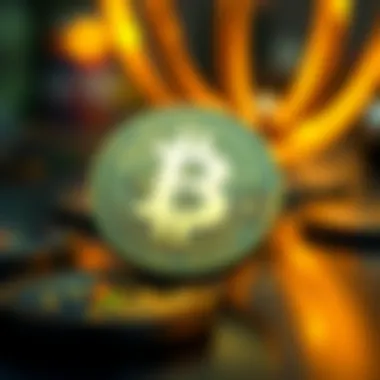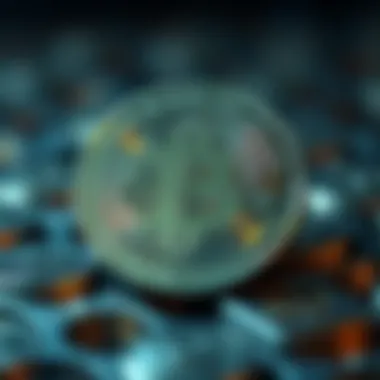Understanding ERC721: A Guide to Non-Fungible Tokens


Intro
In the realm of digital assets, the term ERC721 has emerged as a cornerstone of innovation. It represents a standard—specifically for non-fungible tokens (NFTs)—that has transformed how ownership is perceived and executed in the blockchain ecosystem. While the world buzzes with excitement over avenues like digital art, gaming, and collectibles, understanding the mechanics behind ERC721 can illuminate its pivotal role in the ongoing evolution of ownership and authenticity in the digital space.
The significance of ERC721 surpasses mundane transactions. Non-fungible tokens are unique and irreplaceable, unlike cryptocurrencies such as Bitcoin or Ethereum, which are interchangeable; that's the crux of fungibility. With ERC721, each token can hold distinct attributes, enabling items like digital art pieces, virtual real estate, and limited edition collectibles to be neatly encapsulated within a single token structure. In essence, it marries technology with creativity, paving a path for a fresh wave of innovation.
As this article unfolds, it will dive deep into the foundational elements of ERC721, outlining its characteristics, distinctions from other token standards, and applications in various spheres. By unraveling these layers, you’ll be left with a robust understanding of what this token standard entails and its relevance across broader sectors. So, whether you��’re an investor hoping to capitalize on the next big trend, an educator seeking clarity, or simply someone with a keen interest in cryptocurrency, take a moment to explore this guide with an open mind.
Let's embark on this exploration together.
Prolusion to ERC721
The ERC721 token standard holds a pivotal position in the world of digital assets, especially as the demand for non-fungible tokens (NFTs) continues to skyrocket. Understanding the nuances of this standard is crucial for anyone involved in cryptocurrency, whether you’re an investor looking for the next big thing or an artist seeking to tokenize your work.
Definition of ERC721
ERC721 is a standard that creates non-fungible tokens on the Ethereum blockchain. Unlike other tokens such as ERC20, which are interchangeable and hold the same value, ERC721 tokens represent unique assets. Think of it like owning a one-of-a-kind baseball card. Each ERC721 token has its own distinct characteristics and value, which makes it ideal for representing ownership of digital art, collectibles, and other unique items.
To illustrate, suppose you have a digital painting represented by an ERC721 token. That token not only verifies that you own the painting but also contains metadata, such as the artist's name, title, and even a record of previous ownership.
Historical Context and Development
The inception of ERC721 can be traced back to the growing interest in digital collectibles and how blockchain technology could facilitate true ownership of digital assets. Launched in late 2017, this standard was initiated by the team at Loom Network, aiming to fill the gap left by the Ethereum ERC20 protocol, which primarily focused on fungible tokens.
The first major project to utilize this standard was CryptoKitties, a blockchain-based game that allowed players to buy, breed, and sell virtual cats. This application helped to showcase the potential of ERC721 tokens, illustrating how they could breathe life into the digital art and gaming ecosystems.
However, the journey wasn’t without challenges. Initial adoption faced hurdles like blockchain congestion, high gas fees, and scalability issues. Nevertheless, as more projects emerged, the interest in ERC721 grew, paving the way for a diverse ecosystem where digital ownership started to become a reality. Today, understanding this standard goes beyond mere technical knowledge; it's about grasping a new paradigm in ownership and creativity.
Core Principles of ERC721
The ERC721 token standard has transformed the landscape of digital ownership. Grasping its core principles is crucial for investors, educators, and anyone curious about the digital economy. What sets ERC721 apart from other token standards is the uniqueness of each token, which ties directly into its value proposition. Here we delve into the fundamental principles that shape ERC721.
Non-Fungibility Explained
To understand ERC721, one must first grasp the term 'non-fungibility.' Unlike traditional currencies or commodities, which can be exchanged for one another on a one-to-one basis, non-fungible tokens (NFTs) come with unique identifiers. For instance, a dollar bill can be swapped for another, but an artwork by Van Gogh stands alone—its value lies in its distinctiveness and history.
This is akin to comparing apples and oranges; they're both fruits, yet different in taste and appearance. In essence, non-fungibility signifies that an ERC721 token is irreplaceable, which in turn enhances its market value through rarity.
Unique Metadata
Each ERC721 token is not just a number or string; it is a vessel laden with unique metadata. This metadata serves as a fingerprint, encapsulating essential information about the asset it represents—be it digital art, music, or even virtual real estate. For example, when a digital artist mints a piece of artwork as an ERC721 token, the metadata can include details about the artwork's creation, ownership history, and even the artist's biography.
Such granular data contributes significantly to the token's value. The combination of unique metadata and the non-fungible aspect means that two tokens, even if they exist within the same collection, can hold drastically different values based on their specific attributes. It opens doors to infinite creative possibilities for artists and creators.
Ownership and Provenance


Another keystone of ERC721 is the concept of ownership and provenance. Ownership is straightforward in theory; if you possess an ERC721 token, you own whatever digital asset it corresponds to. Provenance, however, adds another layer of complexity and value, providing a verified history of that ownership.
Consider the world of high-value collectibles. When a buyer considers purchasing a rare token, they often want to know its pedigree—where it’s been, who’s owned it, and what it’s been through. ERC721's architecture makes this verification seamless; thanks to blockchain technology, each token's history is etched permanently, offering transparency that traditional markets often lack.
In summary, the principles of non-fungibility, unique metadata, and clear ownership traceability define the essence of ERC721. As these tokens broaden their applications across various sectors, understanding these key tenets will serve as a solid foundation for navigating the broader impacts of the ERC721 standard on the digital economy.
"Understanding the foundational principles of ERC721 is like having a map in unfamiliar territory; it offers direction and clarity."
The journey of ERC721 is just beginning. Its integration into digital art, real estate, and gaming signifies a paradigm shift not seen before. As we further explore its compare with other token standards, this foundational knowledge will be invaluable.
Comparing ERC721 with Other Token Standards
In the ever-evolving world of blockchain technology, comprehending the differences between token standards is as crucial as understanding the tokens themselves. ERC721, as a staple for non-fungible tokens (NFTs), serves unique functions that other token standards cannot replicate. Delving into how ERC721 stacks up against its counterparts reveals insights that are vital for investors and enthusiasts alike.
Differences Between ERC721 and ERC20
When it comes to token standards, ERC20 and ERC721 are often compared, yet they cater to distinctly different use cases.
- Fungibility: The most notable difference lies in fungibility. ERC20 represents fungible tokens, such as cryptocurrencies, where each unit is identical in value and nature. Simply put, one ERC20 token can be exchanged for another without affecting its worth. Conversely, ERC721 focuses on non-fungibility. Each token has unique properties and represents distinct assets.
- Functionality: ERC20 tokens can be used interchangeably. This makes them ideal for currencies or utility tokens within a platform. On the other hand, ERC721 tokens are tailored for representing ownership of unique items—like digital art or collectibles. Each ERC721 token carries distinct metadata, affirming its individuality.
- Transaction Costs: The transaction mechanics also vary. ERC20 tokens typically require less overhead for transfers due to their fungibility. In contrast, ERC721 transactions often involve more gas fees because of additional metadata attached to each token.
By understanding these differences, investors and developers can effectively strategize their interactions with blockchain assets.
Role of ERC998 and ERC1155
Beyond ERC721 and ERC20, the landscape introduces ERC998 and ERC1155, adding layers to how NFTs can be utilized.
- ERC998: This standard enhances ERC721 by introducing composable NFTs. Essentially, it allows a non-fungible token to own other tokens. Picture a digital artwork that can also hold its own collection of ERC20 tokens or even other ERC721 assets. This opens new doors for developers who want to create games with complex ownership dynamics or marketplaces where one NFT is more than just a single item.
- ERC1155: This standard is a game-changer, integrating both fungible and non-fungible tokens into a single contract. It allows for batch transfers of tokens, which can be incredibly efficient for trading multiple assets in one transaction. An example scenario might be in gaming environments where players can own both unique items and standard currencies. Simplifying transactions while retaining inventory management becomes a streamlined process.
In short, examining ERC721 alongside these newer standards demonstrates its foundational role while highlighting where future innovation is headed. As we explore and innovate within blockchain, understanding these nuances prepares us for what's next in digital ownership.
Practical Applications of ERC721
The emergence of ERC721 has stirred up the digital realm, establishing a new paradigm in ownership and provenance. This token standard doesn’t just sit in the background; it paints a vibrant picture of how digital assets can be utilized across diverse sectors. In this section, we’ll explore the practical applications of ERC721, centering on its transformative potential, especially in digital art, gaming, and real estate.
Digital Art and NFTs
Digital art and ERC721 share a synergistic relationship that has taken the art world by storm. Artists are breaking free from traditional constraints, gifting them the ability to tokenize their work and reach a global audience without intermediaries. Through the lens of ERC721, each piece is not just art but a unique token with embedded provenance, ownership history, and authenticity.
Consider an artist who creates a limited series of illustrations. By minting these unique works as ERC721 tokens, they can guarantee that buyers are purchasing authenticated versions. Cases like Beeple’s "Everydays: The First 5000 Days" auction at Christie's exemplify this trend, showcasing how this technology redefines art sales and ownership.
"With ERC721, artists can tokenize their work, unlocking new revenue streams and fostering a direct relationship to collectors."
Gaming and Virtual Goods
Another arena where ERC721 shines brightly is gaming. In gaming, assets like characters, skins, and items are typically confined to the game world, with no ownership rights beyond gameplay. ERC721 flips this narrative, granting players true ownership over their virtual goods. Gamers can buy, sell, and trade unique items across platforms, blurring the lines between different gaming ecosystems.


For example, in games like Axie Infinity, players own their creatures as ERC721 tokens, allowing for breeding, trading, and competitive play. This not only enhances player engagement but also introduces the notion of earn-to-play, where players can monetize their gaming skills, making it a lucrative venture.
Real Estate and Asset Tokenization
Tokenization of real estate through ERC721 is still in its infancy, but the potential is massive. Imagine breaking down physical properties into unique tokens, each representing a share of ownership. This not only makes investment accessible but also simplifies buying and selling processes.
Consider a scenario where a historic building is tokenized into ERC721 tokens. Investors can purchase tokens representing fractional ownership, allowing for diversification of assets with lower capital outlay. This could democratize access to real estate investment, providing an option for people to invest in properties that were otherwise out of reach.
As we delve deeper into ERC721, it’s clear that its applications stretch beyond a mere token standard. From reshaping the art landscape with NFTs to revolutionizing how we perceive ownership in gaming and real estate, ERC721 embodies a new technological dawn. Understanding these practical implementations paves the way for insights into its future and the broader implications it holds for various industries.
Technical Structure of ERC721
The technical structure of the ERC721 standard is foundational to its significance in the digital asset landscape. Grasping this framework helps investors, educators, students, and tech enthusiasts appreciate how it operates and the myriad implications it carries. Unlike fungible tokens, which are interchangeable, ERC721 redefines ownership by prioritizing distinctiveness. This uniqueness allows users to possess one-of-a-kind items in a digital format—be it art, collectibles, or even virtual real estate.
The key elements of the technical structure encompass contract functions, methods, and interoperability with other protocols, offering a broad spectrum of benefits and considerations.
Contract Functions and Methods
The ERC721 contract is structured through a set of essential functions designed to facilitate the management of non-fungible tokens. The core functions include:
- : This function enables the transfer of ownership, ensuring that when a buyer acquires a token, the original owner's rights cease, while the new owner's rights commence.
- : This method allows token owners to authorize other addresses to transfer a specific token on their behalf—helpful for ensuring smooth transactions or when a token is part of a sale arranged through third parties.
- : This function is critical for verifying ownership of a specific NFT. Knowing who owns what reduces disputes in the digital ownership arena.
- : It indicates the approved address that can make transactions on behalf of the original owner of a specific token—adding another layer of transaction clarity.
Understanding these functions sheds light on how ERC721 doesn't simply facilitate transactions; it creates a reliable framework for ownership definition.
Interoperability with Other Protocols
Interoperability stands as a pillar of ERC721's efficiency. It allows these tokens to interact seamlessly with other blockchain technologies and applications. This is critical in today’s diversified blockchain ecosystem, where multiple protocols may coexist. Some key points include:
- Cross-Platform Usage: ERC721 tokens can function across platforms, creating opportunities for unique digital items to be traded in various markets, exemplifying true digital ownership.
- Encouraging Innovation: By enabling interoperability, developers can leverage the ERC721 standard to create innovative applications that harness these unique tokens for gaming, digital art, and beyond, leading to exponential growth in this space.
- Shared Standards: The common standards facilitate easier integration with wallets, exchanges, and dApps, promoting broader engagement within the blockchain community.
In some cases, this leads to profound collaborative opportunities, pushing the boundaries of what NFTs can achieve beyond individual platforms.
The interconnected nature of ERC721 tokens encourages a richer ecosystem where creative and commercial endeavors can flourish. As such, discerning enthusiasts can leverage the ERC721 framework to dive deeper into a world that is expanding at breakneck speed, exploring what it means to own a digital asset and the broader implications of digital property rights.
Challenges and Limitations of ERC721
The landscape of ERC721 is indeed filled with promise and innovation, yet it is not without its hurdles. Understanding the challenges and limitations of this token standard is crucial for anyone deeply involved in the realm of non-fungible tokens. While ERC721 has transformed how we perceive ownership, various elements pose substantial risks for investors, developers, and enthusiasts alike. Let's delve into the key challenges, primarily focusing on market volatility and scalability concerns, which can significantly impact the viability of ERC721 in the long run.
Market Volatility and Speculation
Market volatility is perhaps one of the most pressing challenges associated with ERC721 tokens. The prices of non-fungible tokens can swing wildly, with moments of extreme highs and lows that leave even the most seasoned investors biting their nails. The speculative nature of many NFT markets often drives this volatility.
For instance, an artist may sell a digital artwork for a staggering amount one day, only to see that same token's value plummet days later as trends fluctuate. This erratic price behavior can make it difficult for buyers and sellers to make informed decisions.
"NFTs are a bit like a whack-a-mole game; just when you think you've got it down, the next trend pops up and sends prices in a tailspin."


Factors contributing to this unpredictability often include:
- Market trends: Buzz in pop culture can sometimes inflate an NFT's price momentarily, but those bubbles often burst.
- Rarity and uniqueness: The perception of what makes a token valuable can shift dramatically.
- Social media influence: Viral moments on platforms like Twitter or Instagram can wildly affect perceptions and prices, further fuelling speculation.
These elements combined mean that while the potential for profit is enticing, the risks inherent in volatility remain a significant barrier. Appreciating this aspect is essential for anyone considering investment in ERC721 tokens.
Scalability Concerns
Another considerable limitation facing ERC721 is scalability. As the use of non-fungible tokens grows, so does the demand on the blockchain platforms that house them. Current infrastructure often struggles to keep pace with the increasing number of transactions, which leads to various issues, such as high gas fees and slow transaction times.
Ethereum, the predominant platform for ERC721, is notorious for these problems. When the network becomes congested, it can cause delays in minting or transferring NFTs, which frustrates both creators and collectors.
Additionally, these scalability challenges push many emerging projects towards alternative blockchains or layer-2 solutions. However, this bifurcation can dilute the market and lead to fragmentation, wherein NFTs on different platforms may not easily interact with each other. This clash can hinder interoperability, one of the core ideals behind token standards like ERC721, limiting their potential as a cohesive ecosystem.
To summarize, recognizing the challenges of market volatility and scalability can help ensure that participants in the ERC721 space make informed decisions. By being aware of these limitations, one can better navigate the complexities of non-fungible tokens and mitigate risks associated with their investment or development.
Future Directions for ERC721
The journey of ERC721 has merely scratched the surface, and the future holds a promising vista for non-fungible tokens (NFTs). Understanding these future directions is crucial for investors, educators, and enthusiasts who wish to navigate this evolving landscape. As technology progresses, so do the opportunities and challenges associated with ERC721. Therefore, it's vital to highlight potential innovations and their implications on digital ownership.
Potential Innovations in Token Standards
The world of blockchain is constantly evolving. With ERC721 being a foundational stone for non-fungible tokens, its potential is ripe for innovation. Emerging concepts are being discussed that can augment the functionalities of ERC721, such as:
- Dynamic NFTs: Imagine a scenario where NFTs evolve over time. Their attributes could reflect real-world changes, adding a layer of depth that static tokens simply lack. Think about a digital art piece that changes based on seasons—it could be a fascinating interaction with collectors.
- Interoperable Tokens: The future may see increased interoperability between different blockchain platforms. This would allow users to trade or interact with their ERC721 tokens across varied ecosystems seamlessly. The notion of flexibility could be a game changer for possessors of unique digital assets.
- Fractional Ownership: By breaking down high-value NFTs into smaller, tradable units, more users could participate in ownership. This opens doors for broader investment strategies, making once exclusive pieces accessible to a wider audience.
These innovations, among others, are not merely speculative. Developers are actively engaged in research and experimentation. The aim is to enhance user experience while addressing limitations in scalability and market dynamics.
Impact on Digital Ownership and Beyond
As we gaze into the future, the implications of ERC721 extend far beyond the realm of arts and collectibles. The impact of these tokens on digital ownership challenges traditional notions of how we regard ownership itself.
- Shifts in Consumer Behavior: With the advent of NFTs, ownership is no longer confined to tangible items. Consumers may start valuing exclusive digital items as much as physical ones. This shift could influence marketing and sales strategies across various industries, where brands integrate NFTs into their customer engagement.
- Legal Frameworks: As tokenized ownership gains traction, it may spur new legal considerations. Legal systems will have to adapt to effectively regulate and protect digital ownership rights. This evolution could lead to more robust frameworks that also address fraud within the digital space.
- Cultural Implications: NFTs could redefine what it means to collect and curate. Cultural institutions may leverage ERC721 to preserve and promote heritage through digital tokens, fostering a new era of accessibility.
The bottom line is that the future direction of ERC721 isn’t just about advancement; it’s about reshaping realities.
Ending
In this concluding section, we look back on the significance of ERC721 within the broader landscape of digital ownership and tokenization. This token standard has not only disrupted traditional notions of ownership but also paved the way for creativity and innovation across various fields. By moving from fungibility—where one token is indistinguishable from another—to non-fungibility, ERC721 enables the representation of unique digital assets, allowing for greater individuality and value.
Summarizing Key Points
To summarize, the fundamental takeaways regarding ERC721 are:
- Non-fungibility: Unlike ERC20 tokens, each ERC721 token is distinct, possessing its unique properties, thereby serving well in applications like digital art and collectibles.
- Ownership and Provenance: The embedded metadata in ERC721 tokens allows verifiable ownership and histories of each asset, addressing issues surrounding authenticity and fraud.
- Practical Applications: The real-world use cases range from digital art galleries and gaming assets to real estate, suggesting a broader potential that extends beyond mere cryptocurrency.
- Challenges and Innovations: Despite market volatility and scalability issues, the ongoing dialogue around improving token standards hints at an evolving landscape that could address current limitations.
The Importance of Understanding ERC721
Grasping the concepts behind ERC721 is essential for various stakeholders. For investors, recognizing the differentiating features of ERC721 tokens can guide better decision-making, especially when assessing their market value. Educators and students benefit from this knowledge by being part of the conversation around digital assets and blockchain technology. Analysts can leverage insights gained from ERC721 to forecast trends in asset valuation and digital rights management.
Moreover, for enthusiasts, understanding ERC721 not only fosters an appreciation for the tech behind digital ownership but also empowers them to participate actively in the community around non-fungible tokens. As we move towards a future where digital assets grow in importance, being equipped with insights about ERC721 will be invaluable, facilitating informed discussions and strategic investments in a rapidly changing environment.



